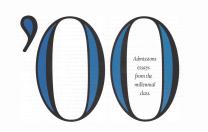Harvard College announced today that 2,056 students have been offered admission to the class of 2021 (including the 938 accepted last December under the early-action program). The College received a record 39,506 applications this year, up just 1 percent from the 39,041 candidates last year. The very slight increase in applicants translated into an admission rate of 5.2, nearly identical to last year’s. For the decimally obsessed, the rate decreased to 5.20 percent, from 5.22 last year, making this year’s the lowest-ever admission rate. (To view the admission rate over time, consult the University Fact Book.)
First-generation college students represent 15.1 percent of admits, up slightly from 15 percent last year. Slightly more of this year’s students are African-American and Asian-American (14.6 and 22.2 percent, respectively), but the proportion of Latino students is down slightly to 11.6 percent from last year’s 12.7 percent.
“Since launching the Harvard Financial Aid Initiative in 2005, Harvard has been able to attract ever-increasing numbers of outstanding students from a much wider range of backgrounds than in the past. During this time, the applicant pool has doubled in size,” said William R. Fitzsimmons, dean of admissions and financial aid, in a news release.
In their academic interests, students are broadly similar to last year’s cohort: “26.5 percent indicate an interest in social sciences, 19.3 percent in computer science and engineering, 19.2 percent in the biological sciences, 15.5 percent in the humanities, 7.2 percent in mathematics, 6.9 percent in the physical sciences, and 5.4 percent are undecided.”
The Term Bill
Total cost of attendance—tuition, room, board, and fees—in academic year 2017-2018 will exceed $65,000 for the first time: at $65,609, that represents an increase of 4.1 percent from this year’s $63,025 term bill. This represents a slight acceleration from the prior year’s 3.9 percent increase; the fact book provides a history of undergraduate term bills extending back to 1985—when the bill, not adjusted for inflation to today’s dollars, was $14,100. The bill crossed the $20,000 threshold in academic year 1990-1991; $30,000 in 1997-1998; $40,000 in 2005-2006; $50,000 in 2010-2011; and $60,000 in 2015-2016.
Economic Access
The list price, of course, does not reflect financial aid. The College remains free for students from families whose income is less than $65,000. Families with incomes of up to $150,000 pay 10 percent or less of income.
The College’s news release notes that the class of 2021 includes more low- and middle-income students. Harvard does not disclose detailed information about students’ socioeconomic backgrounds, but earlier this year, a massive new data set revealed that more than half of undergraduates come from families in the top 10 percent of the income distribution. That number comes from the most recent class for which data was available—approximately the class of 2013. The study suggested that there exist many more low-income students with the potential to succeed at Harvard; the College’s financial aid initiative, and other, more recent programs, aim to recruit and better integrate such students.
Last fall, the College rolled out a new, experimental “start-up grant” for freshmen whose family income is $65,000 or less—about 20 percent of each class. Eligible students receive grants of $2,000 to spend on whatever they choose, like books or meals out. The grants are intended to ease students’ transition to life at Harvard, enabling them to participate fully in the academic and social experience. This fall will mark the second year of the program’s three-year pilot.
The College also plans to create a part-time position in the Freshman Dean’s Office devoted to advising first-generation and low-income students, The Harvard Crimson reported this week, though it has declined to create a summer bridge program for first-generation students, as some peer schools have done, and as some current students have called for.









